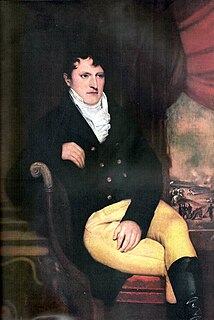
The Buenos Aires Underground, locally known as Subte, is a rapid transit system that serves the area of the city of Buenos Aires, Argentina. The first section of this network opened in 1913, making it the 13th subway in the world, and first underground railway in Latin America, the Southern Hemisphere and the Spanish-speaking world, with the Madrid Metro opening five years later, in 1919. As of 2015, Buenos Aires is the only Argentine city with a metro system, but there is a proposal to build a metro in the city of Córdoba, while a proposal to build a metro in Rosario was shelved in favour of a tramway network.

The Belgrano Norte line is a commuter rail service in Buenos Aires, Argentina run by the private company Ferrovías since 1 April 1994, with some services operated by the state-owned company Trenes Argentinos from 2015. This service had previously been run by the state-owned General Belgrano Railway since nationalisation of the railways in 1948. Ferrovías also formed part of the consortium UGOFE which operated other commuter rail services in Buenos Aires.

The Roca line is a 1,676 mm gauge commuter rail service in the city of Buenos Aires, Argentina, part of General Roca Railway network. The service is currently operated by State-owned company Trenes Argentinos, from the city-centre terminus of Constitución south to Alejandro Korn, Cañuelas-Ezeiza, and La Plata, and west to Sarmiento Line's station Haedo. The transfer stations between the branch lines are Darío Santillán y Maximiliano Kosteki, Bosques, Berazategui and Temperley.
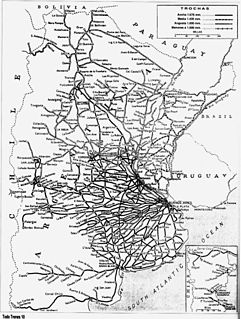
The Argentine railway network consisted of a 47,000 km (29,204 mi) network at the end of the Second World War and was, in its time, one of the most extensive and prosperous in the world. However, with the increase in highway construction, there followed a sharp decline in railway profitability, leading to the break-up in 1993 of Ferrocarriles Argentinos (FA), the state railroad corporation. During the period following privatisation, private and provincial railway companies were created and resurrected some of the major passenger routes that FA once operated.

The Argentina Bicentennial was a series of ceremonies, festivals, and observances celebrated on May 25, 2010 and throughout the year. They commemorated the 200th anniversary of the May Revolution, a sequence of historical events that led to the Viceroy Baltasar Hidalgo de Cisneros being ousted from office and replaced with the Primera Junta, the first national government.

The Inca plan was a proposal formulated in 1816 by Manuel Belgrano to the Congress of Tucumán, aiming to crown an Inca. After the Declaration of Independence of the United Provinces of South America, the Congress discussed the form of government that should be used. Belgrano proposed that the country be ruled by a Constitutional monarchy headed by an ethnic Inca. The proposal was supported by José de San Martín, Martín Miguel de Güemes and the northern provinces, but found strong resistance from Buenos Aires. The Congress would ultimately reject it, creating instead a Republican government.
Between 1 and 3 April 2013, the northeastern section of Buenos Aires Province, Argentina, experienced several flash floods that claimed the lives of 101 people. Greater La Plata was hardest hit with 91 reported deaths, and Greater Buenos Aires reported 10 deaths. The flooding was the result of extremely heavy rainfall and is said to be the worst flooding in La Plata's history.
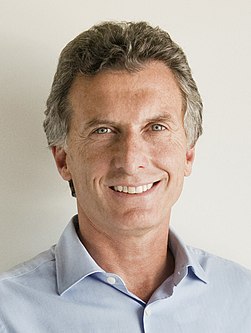
General elections were held in Argentina on 25 October 2015 to elect the President and National Congress, and followed primary elections which were held on 9 August 2015. A second round of voting between the two leading candidates took place on 22 November, after surprisingly close results forced a runoff. On the first runoff voting ever held for an Argentine Presidential Election, opposition leader and Buenos Aires Mayor Mauricio Macri narrowly defeated FPV candidate and Buenos Aires Province Governor Daniel Scioli.

Operadora Ferroviaria Sociedad del Estado is an Argentine State-owned company created in 2008 to operate passenger services in Argentina. It is a subsidiary of the Ferrocarriles Argentinos holding company.

Ferrocarriles Argentinos Sociedad del Estado is a State-owned railway company of Argentina created for the operation and maintenance of the Argentine railway network in the country, including passenger and freight services. The company shares its name with the previous national operator which was broken up during the privatisation process, and also uses a modified version of its original logo.

Horacio Rodríguez Larreta is an Argentine politician and current Head of Government of the Autonomous City of Buenos Aires.

Red de Expresos Regionales is a planned mass transit system in Buenos Aires which will connect the main rail terminals of the city through 16 km (9.9 mi) of tunnels with a central terminal. The tunnels will mean that the existing 815 km (506 mi) commuter rail network will be connected, with passengers being able to travel from one part of Greater Buenos Aires and La Plata to the other while only making one change at the new underground central terminal. The project is modelled on the Réseau Express Régional in Paris. It is estimated that after the completion of the project, combined with the current renewal of the commuter rail lines' rolling stock, passenger numbers will double from 1.4 million passengers per day to 3 million.
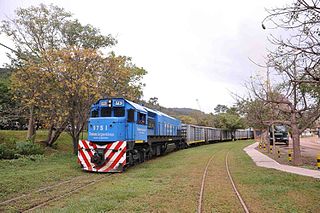
Belgrano Cargas y Logística S.A. is an Argentine State-owned company which operates a 15,305 km (9,510 mi) freight rail network that includes Belgrano, Urquiza and San Martín railways. It is a subsidiary of the Ferrocarriles Argentinos holding company.
Cambiemos is an Argentine big tent political coalition created in 2015. It is composed of the Republican Proposal (PRO), the Radical Civic Union (UCR), and the Civic Coalition (CC-ARI). These three parties respectively nominated Mauricio Macri, Ernesto Sanz, and Elisa Carrió as their representatives in the August 2015 primary elections, which were held to choose which candidate would run in the 2015 presidential election on October 25. On August 9, 2015 Mauricio Macri was elected as the candidate who would represent Cambiemos in the presidential election; on November 22 he won the presidential election.

The CSR EMU is a series of electric multiple unit cars manufactured by CSR Corporation Limited for use on Buenos Aires' commuter rail network. The trains operate on three of the city's lines as of 2015 and 705 cars were manufactured, with each line using a different number of cars per train. They were created for use on lines electrified using both third rail and overhead lines.

María Juliana Awada Baker is an Argentine businesswoman and philanthropist of Lebanese and Syrian descent. She is the current First Lady of Argentina, married to the 53rd President of Argentina, Mauricio Macri.

The Presidency of Mauricio Macri began on 10 December 2015, when Mauricio Macri was sworn into office on 10 December 2015 to a four-year term as President of Argentina. Macri took office following a 51.34% to 48.66% runoff ballotage win over Daniel Scioli in the 2015 general election. He is Argentina's first democratically-elected non-Radical or Peronist president since 1916.
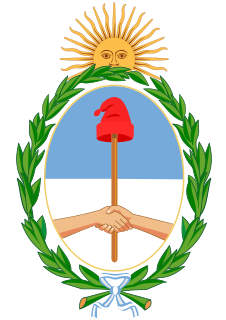
General elections will be held in Argentina on 27 October 2019, to elect the president of Argentina, members of the national congress and the governors of most provinces. Mauricio Macri is the sitting president, and will run for re-election.

